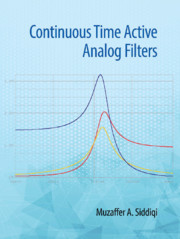Book contents
- Frontmatter
- Dedication
- Contents
- Preface
- Acknowledgments
- 1 Analog Filter: Concepts
- 2 First-and Second-order Filters
- 3 Magnitude Approximations
- 4 Delay: Approximation and Optimization
- 5 Frequency and Impedance Transformations
- 6 Sensitivity of Active Networks
- 7 Single Amplifier Second-order Filters
- 8 Multi Amplifier Second-order Filter Sections
- 9 Direct Form Synthesis: Element Substitution and Operational Simulation
- 10 Cascade Approach: Optimization and Tuning
- 11 Amplification and Filtering in Biomedical Applications
- 12 Audio Signal Processing and Anti-aliasing Filters
- 13 Follow the Leader Feedback Filters
- 14 Switched Capacitor Circuits
- 15 Operational Transconductance Amplifier-C Filters
- 16 Current Conveyors and CDTA (Current Differencing Transconductance Amplifiers) Based Filters
- 17 Active R and Active C Filters
- Index
- References
10 - Cascade Approach: Optimization and Tuning
Published online by Cambridge University Press: 24 December 2019
- Frontmatter
- Dedication
- Contents
- Preface
- Acknowledgments
- 1 Analog Filter: Concepts
- 2 First-and Second-order Filters
- 3 Magnitude Approximations
- 4 Delay: Approximation and Optimization
- 5 Frequency and Impedance Transformations
- 6 Sensitivity of Active Networks
- 7 Single Amplifier Second-order Filters
- 8 Multi Amplifier Second-order Filter Sections
- 9 Direct Form Synthesis: Element Substitution and Operational Simulation
- 10 Cascade Approach: Optimization and Tuning
- 11 Amplification and Filtering in Biomedical Applications
- 12 Audio Signal Processing and Anti-aliasing Filters
- 13 Follow the Leader Feedback Filters
- 14 Switched Capacitor Circuits
- 15 Operational Transconductance Amplifier-C Filters
- 16 Current Conveyors and CDTA (Current Differencing Transconductance Amplifiers) Based Filters
- 17 Active R and Active C Filters
- Index
- References
Summary
Introduction
In Chapter 2, a number of first-order active filters were realized along with the basic configuration of bilinear functions. Chapters 7 and 8 were devoted to the development of second-order filter sections using one or more than one OA (operational amplifier). However, as mentioned earlier, all filter specifications are not achievable only through second-order sections; higher-order filters become necessary. For the realization of higher-order filters, ladder simulation techniques through element (inductor/frequency dependent negative resistor: FDNR) substitution was discussed in Chapter 9. Ladder simulation using signal flow graph technique, which is better known as the operationally simulated method was also discussed in Chapter 9. The present chapter deals with another basic method of realizing higher-order filter sections known as the cascade design method.
Section 10.2 will discuss the basics of cascade design and the conditions to be satisfied by first- or second-order sections in order that these could be used for cascading and obtaining higher-order filters. After taking up some examples of cascade design, the importance of cascade optimization will be discussed in Section 10.3 through an example section. While cascading a number of second-order sections, a proper combination of poles and zeroes (Section 10.3.1), correct assignment of gain for each section (Section 10.3.2) and their proper order (Section 10.3.2) play a very crucial role. Hence, all the three aspects will be discussed in some details.
It is well-known that due to the tolerance associated with passive elements as well as with the parameters of the active elements, and their possible variation due to the change in the biasing voltage and operating temperature, filter parameters gets deviated. Therefore, it is imperative to provide on-chip tuning of the parameters, especially the pole frequency ωo and pole-Q of the individual second-order sections used in the cascade. This chapter introduces the idea of filter parameter tuning. In Section 10.4, we get a better insight into the cascade design method of filter design.
Cascade Design Basics
To realize higher-order filters, cascading of second-order sections finds considerable favour in the eyes of a majority of filter designers; a first-order section is also cascaded in case of an oddorder filter. It will be shown later that such a technique has few advantages like the ability to tune filter parameters easily, and that it possess controlled tunability of the filter parameters with respect to the elements used.
- Type
- Chapter
- Information
- Continuous Time Active Analog Filters , pp. 299 - 333Publisher: Cambridge University PressPrint publication year: 2020



